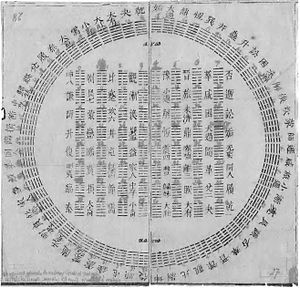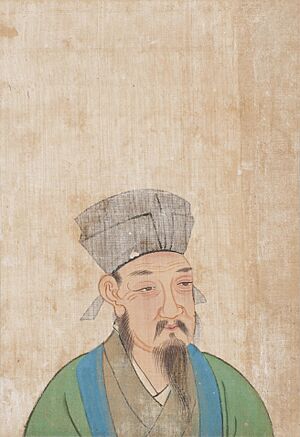Shao Yong facts for kids
Shao Yong (1011–1077) was a very smart Chinese thinker. He was known as a cosmologist, historian, philosopher, and poet. He lived during the Song dynasty in China. Shao Yong had a big impact on a way of thinking called Neo-Confucianism.
Even though he was one of the smartest people of his time, Shao Yong never worked for the government. He wrote an important book called Huangji Jingshi, which means Book of supreme world ordering principles. This book was about how the universe works.
Contents
Where Shao Yong Came From
Shao Yong was born in 1011 in a place now called Anyang, Henan. His family came from Fanyang. His parents were Shao Gu (his father) and Lady Li (his mother).
Shao Yong's mother, Lady Li, was a very strong follower of Buddhism. This connection to Buddhism had a big effect on Shao Yong's ideas throughout his life.
Learning from His Family
Shao Yong's first teacher was his father, Shao Gu. This was a common way for children to learn in China back then. His father was a scholar who studied language. You can see his father's influence in Shao Yong's writings.
Guided by his father, Shao Yong studied the Six Confucian classics when he was young. He also went to private schools. Many of these schools were run by monks and were influenced by Buddhist ideas.
Around 1020, Shao Yong's family moved to a place now called Xinxiang, Henan. After his mother passed away in 1032 or 1033, Shao Yong met his most important teacher, Li Zhicai. Li Zhicai had studied the I Ching (a very old Chinese book) a lot.
Shao Yong's Work and Later Years
Shao Yong was part of a group of thinkers who met in Luoyang in the late 1000s. This group had two main goals. First, they wanted to connect their own ideas with Confucianism, as taught by Mencius.
Second, they wanted to show that Confucianism was different from other ways of thinking, like Buddhism and Taoism. Other thinkers in this group included Cheng Yi, Zhang Zai, Cheng Hao, and Zhou Dunyi.
Studying the I Ching
The ancient book I Ching was very important to all these thinkers. However, Shao Yong studied it in a different way from the others.
During the Song Dynasty, there were two main ways to study the I Ching. Most scholars, including the other members of Shao Yong's group, used the "principle study" approach. This way focused on the literal and moral meanings of the text.
Shao Yong, however, used the "image-number study" approach. This method focused more on pictures and numbers, and how they related to the universe. A way of telling the future using the I Ching, called Mei Hua Yi, is thought to have come from him.
Shao Yong's close friend, Sima Guang, edited another old book called the Taixuanjing. This book used a base 3 number system. Shao Yong was influenced by this. He then arranged the Hexagrams of the I Ching into a binary sequence. This arrangement later influenced a famous European thinker named Leibniz. Leibniz's ideas about binary numbers are now used in modern computers!
Shao Yong's Descendants
Shao Yong's family members were given a special title called Wujing Boshi. This title was given to important scholars' families. In 1630, Shao Yong's descendants received this honor.
Shao Yong's Poetry
Shao Yong was also famous for his poems. He was very interested in the game of Go, also known as wéiqí. He wrote two long poems about watching Go. One is called Great Ode to Watching Wéiqí, and the other is Long Ode to Watching Wéiqí.
Here is a part of his Long Ode to Watching Wéiqí:
See also
- History of the Song Dynasty
- Wen Wang Gua




